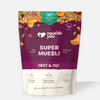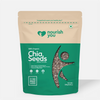
Best sources of fibre, benefits & recipes | Vegan
Looking to eat more fibre in your diet? A plant-based or vegan diet is the best way to eat more fibre, naturally and tastefully! The options are truly unlimited, so let's take a look at the best sources of fibre on a vegan diet.
What is fibre?
Dietary fibre is a type of carbohydrate your body can't digest, unlike other carbs which are broken down into sugar. It is basically the indigestible parts of plant-based foods. So how can fibre be important if you can't digest it?
The fibre you consume in food passes into the intestine, absorbs water, and creates "bulk" so that the muscles in the intestine can push waste out of the body. Without eating enough fibre, you could experience a variety of health issues, some as serious as cancer.
What are the benefits of fibre?
Most of us need to consume more fibre in our diet, and the importance of fibre in the diet cannot be overstated.
Fibre benefits:
- Helping you feel fuller
- Aiding in weight loss
- Reduced risk of heart disease, stroke, type 2 diabetes, obesity, bowel cancer, and stroke
- Improved blood sugar control & insulin sensitivity
- Lower cholesterol
- Improved digestion
- Better gut health
- Prevents constipation
The benefits don't stop here! Fibre may not be the most exciting nutrient for many people, but there's so much to be gained from consuming it. In fact, you may even live a longer life if you consume enough fibre!
How much fibre is needed per day?
For both men and women up to the age of 50, the daily intake for dietary fibre should be 38 grams and 25 grams, respectively. After the age of 50, fibre needs decrease.
Sources of fibre
Because fibre is the part of fruits and vegetables that your body doesn't digest, low-fibre foods are much more limited, and typically not vegan friendly: meat, eggs, cheese, butter, curd, processed meats, dairy, and so on.
The good news is that there are plenty of high-fibre vegan foods, and they can all be easily found at your local produce stand or grocery store, and they're much more affordable (and healthier) than animal products.
Fibre-rich foods:
- Fruits high in fibre: Berries, apples, bananas, oranges, pomegranates, pineapple, butter fruit, and mangoes.
- Vegetables high in fibre: Broccoli, carrots, cauliflower, green beans, okra, bell peppers, palak, squash, cabbage, and beets.
- Cereals & millets. Wheat, oats, paddy, barnyard millets, barley, brown rice, maize, quinoa, and rye.
- Pulses. Rajma, peas, red gram, masoor dal, black gram, kabuli chana, moong dal, and lobiya.
- Potatoes.
- Popcorn. Yes, really!
- Nuts & seeds. Almonds, walnuts, pecans, chia seeds, and flax seeds.
Not only are all these foods rich in fibre, they’re absolutely delicious and are commonly eaten in Indian cuisine, which is a win-win for vegans in India!
Foods high in fibre, per serving
- Chia seeds. 34 grams per 100 gram serving.
- Flax seeds. 28 grams per 100 gram serving.
- Rajma. 25 grams per 100 gram serving.
- Popcorn. 13 grams per 100 gram serving.
- Rolled oats. 8 grams per 1 cup.
- Masoor dal. 8 grams per 1 cup.
- Whole wheat pasta. 8 grams per 100 gram serving.
- Peas. 5 grams per 100 gram serving.
How to eat more fibre
There are many ways to increase your fibre intake each day. You can do this by following these helpful tips:
- Eat whole fruits instead of fruit juices
- Eat more fruits and vegetables in your favourite foods! They are packed with fibre
- Replace white bread, pasta, and flour with whole grains
- Eat more foods with their skins on, like potatoes
- Add more nuts and seeds to baked goods, pudding, or smoothies
- Consume fibre-rich foods that have 5 grams of fibre or more per serving
Because fibre absorbs water, it's important to consume more water after having meals or snacks with fibre-rich foods.
High-fibre diet
A high-fibre diet contains foods that have at least 5 grams of fibre per serving, or more. As one should expect, a high-fibre diet contains a lot of fibre!
On the other end, low-fibre diets can lead to constipation, abdominal pain, gas, bloating, and weight gain. And over time, a diet low in fibre can cause serious health issues, as mentioned above.
What are the 3 types of fibre?
Not all fibre is created equally, there are actually three different types of fibre that we need to consume.
- Insoluble fibre. This type of fibre is not broken down, and moves through the digestive process completely intact. Sources: whole grains, carrots, rajma, raisins, nuts and seeds.
- Soluble fibre. This type of fibre dissolves in water to make it easier for food to pass through your digestive system. Sources: rajma, peas, apples, butter fruit, and flax seeds.
- Fermentable fibre. This type of fibre is converted into energy throughout digestion. Sources: bananas, onions, and garlic.
High fibre recipes
Getting hungry? Try our very own high-fibre vegan recipes!
If you enjoyed this blog post, check out some of our other blogs on vegan nutrition!
- Vitamin D 101 for vegans
- What foods can you eat on a vegan diet?
- How one nutritionist, chef, and vegan gets enough protein on a plant-based diet
- How whole, plant-based foods may promote healthy ageing
- Vegan foods loaded in iron
- 5 best vegan protein sources
- Do vegans need to supplement with vitamin B12?
- Do vegans get enough protein?











Comments
Leave a comment